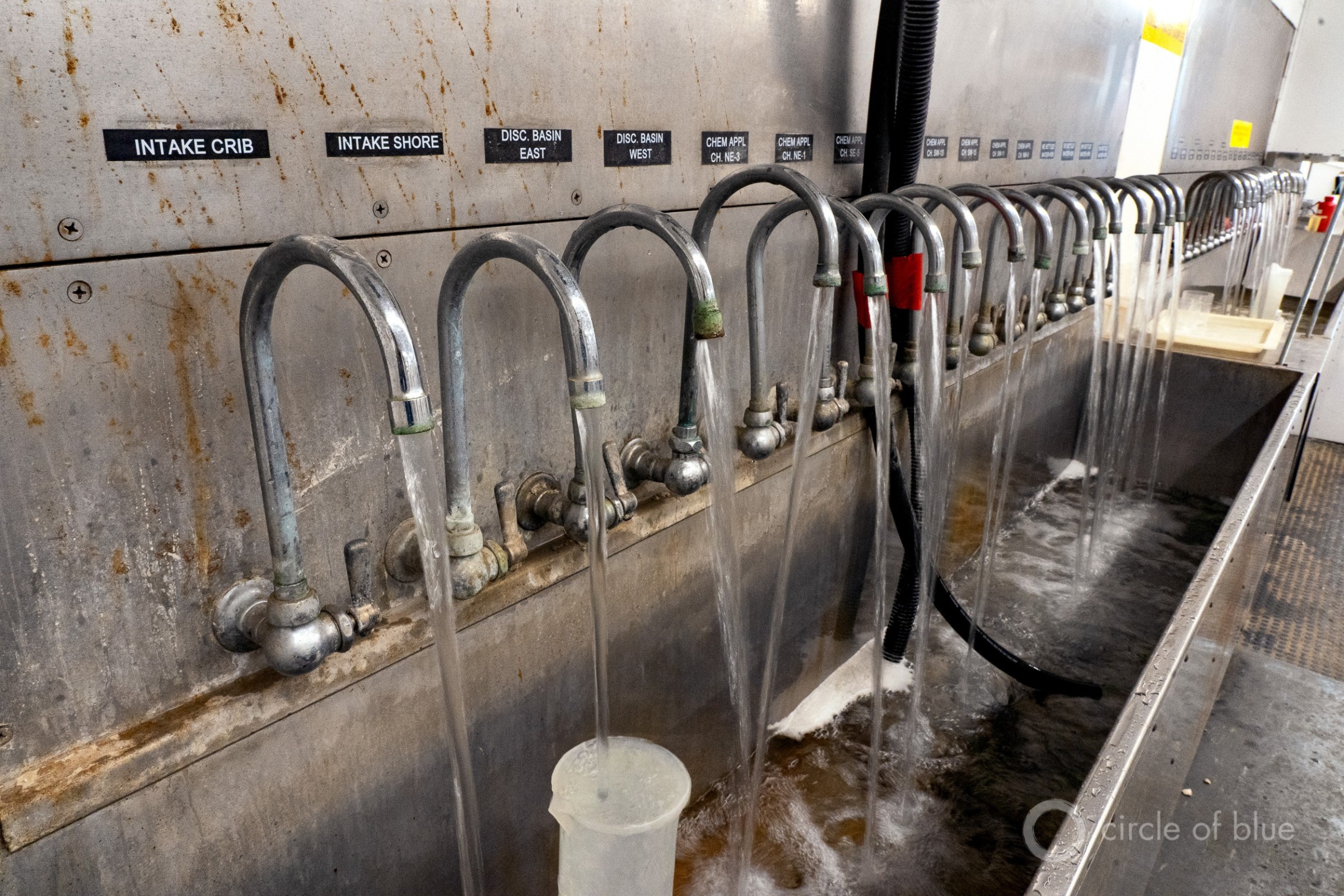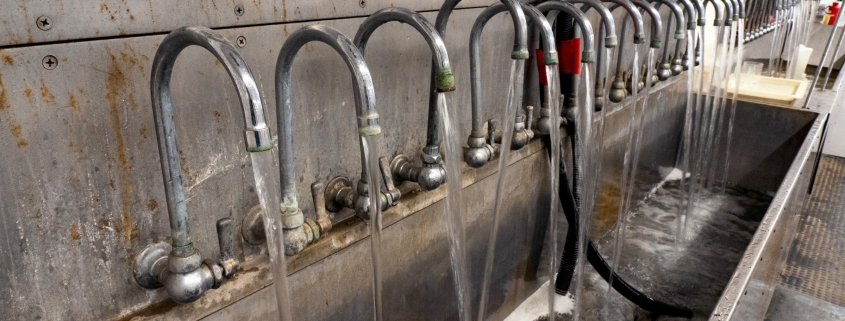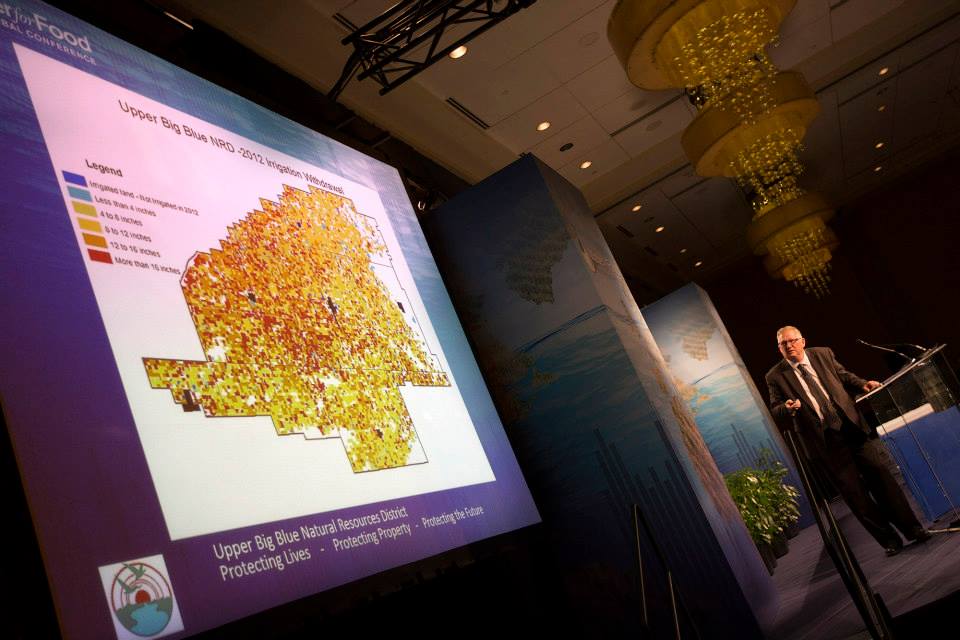In Broad Strokes, Biden Infrastructure Plan Sketches a Future for Federal Water Spending
Administration’s historic pitch to remove all lead drinking water pipes is part of a $111 billion proposal for water systems.

In Chicago’s Jardine Water Purification Plant, a bank of faucets releases water from various points in the system. Photo © Alex Garcia / Circle of Blue
Key Takeaways
- The Biden administration is proposing the American Jobs Plan, a wide-ranging jobs and infrastructure plan, and among its many parts it includes $111 billion for water systems.
- $45 billion of the plan will go towards removing all of the United States’ estimated 6 million to 10 million lead drinking water lines.
- Many questions remain around the implementation of the plan. Most notably concerns are in regard to how funding will be allocated and how to ensure marginalized communities are not left behind.
By Brett Walton, Circle of Blue
President Joe Biden unveiled a wide-ranging jobs and infrastructure plan on Wednesday, asking Congress to support a $2 trillion investment in the built and natural systems that sustain American life, from trips to the grocery store to a glass of water from the faucet.
The administration is calling the proposal the American Jobs Plan, and among its many parts it includes $111 billion for water systems. A month after winter storms crippled water and electric providers in Louisiana, Mississippi, and Texas, the plan also calls for $50 billion to prepare the country’s infrastructure for an era of severe floods, droughts, wildfires, and hurricanes.
Like much of the plan, the $111 billion in water systems funding is described in broad strokes and headline numbers that sidestep, for now, details on how the money would be allocated. As part of that total, the plan offers $10 billion for monitoring and cleaning up toxic PFAS chemicals and investing in rural water systems, household wells, and septic units. The plan includes $56 billion for modernizing drinking water, wastewater, and stormwater conveyance and treatment.
Nathan Ohle, chief executive officer of Rural Community Assistance Partnership, said that his organization, which assists small communities with infrastructure needs, applauds the plan.
“Specifically, we deeply appreciate the plan’s comprehensive approach to investing much needed federal resources towards our nation’s aging water infrastructure, protecting vulnerable populations, and supporting our rural and regional economies,” Ohle wrote to Circle of Blue in an email.
Notably for water and public health, the administration proposes substantial funding to eliminate lead service lines that are a source of the brain-damaging chemical.
“The American Jobs Plan will put plumbers and pipefitters to work, replacing 100 percent of the nation’s lead pipes and service lines so every American, every child can turn on a faucet or a fountain and drink clean water,” Biden said during a speech in Pittsburgh to announce the plan.
In a discussion with reporters, a senior White House official emphasized the lead pipe replacement initiative, calling it “a bold but a very practical goal” for clean water, mentioning also the need to target lead in schools and childcare centers.
The $45 billion that the administration wishes to allocate to the task is in the ballpark for what it would cost to remove all of the country’s estimated 6 million to 10 million lead drinking water lines, according to Elin Betanzo, founder of the consulting firm Safe Water Engineering.
“This is a plan we have been waiting for since the 1986 ban on the installation of new lead service lines, which included no requirements to remove the lead service lines already installed,” Betanzo wrote to Circle of Blue in an email.
The proposal to remove all lead service lines runs counter to a recent U.S. Environmental Protection Agency rulemaking, though. In December, the Trump administration completed long-awaited revisions to federal rules on lead in drinking water. To the chagrin of public health advocates, the revisions did not order removal of all lead service lines.
In light of those concerns, the Biden administration said on March 12 that it was delaying the rule’s implementation. The EPA said it would also open additional rounds of public consultation. The moves give the agency’s new leadership more time to review rules that were finalized at the end of the Trump administration. The agency’s review is expected to be completed in December.
Sri Vedachalam, water program director at the Environmental Policy Innovation Center, said that the administration will be looking at how to reconcile these two positions: on the one hand, stating publicly that it has a goal of total lead service line replacement, while on the other reviewing a rule that does not mandate such action.
Vedachalam told Circle of Blue that the tension between offering financial carrots for lead pipe removal but not requiring that utilities do so could be maintained, but “from a messaging perspective, it’s not at all compatible.”
Other administration objectives will also be put to the test.
Biden stated in an executive order on the climate crisis that 40 percent of the benefits of federal climate spending will go toward low-income areas and communities of color. The $50 billion he proposes for infrastructure resilience should be similarly targeted, argues Sara Hughes of the University of Michigan.
“Climate resilience is a public good, and we should be taking steps to make sure that those who need protection and investment are both prioritized and involved,” Hughes, who researches urban water and climate policy, wrote in an email to Circle of Blue.
Unanswered Questions
Water sector observers now await more details on the nuts and bolts of the Biden infrastructure plan as administration officials work with Congress to turn the proposal into reality.
Tommy Holmes, legislative director at the American Water Works Association, an industry group, listed a number of questions: How much funding will be in the form of grants versus loans? Will new programs be created? Will funding be constrained to a certain time period or will it be open-ended? How much funding for infrastructure renewal will go through the state revolving funds versus WIFIA?
The state revolving funds, a pair of federally funded, low-interest loan programs for drinking water and sewer/stormwater, are administered by the states. WIFIA is a low-interest loan program overseen by the EPA that is geared toward large water projects. Both are favored by Congress. Just last week, the Senate Environment and Public Works Committee advanced a bill that authorizes $14.7 billion over five years for both the Drinking Water and Clean Water state revolving funds.
The funding details will be especially important for lead service line replacement. State revolving funds are loans that must be repaid, which puts pressure on communities that are already financially struggling.
The revolving funds also require that states provide 20 percent in matching funds. Vedachalam speculated that some states might be reluctant to provide the required match if there is a large increase in the revolving funds.
Hughes said a workaround would be to strike state match requirements for loans directed at lead pipe replacement.
“New funds for lead pipe replacements should try to target those communities least able to absorb new water rate increases — specifically, those communities with low income levels and/or high poverty rates,” Hughes said.
Targeting disadvantaged communities is a sentiment that Biden has brought to the forefront of his policy proposals. He expressed it again in his speech in Pittsburgh.
“Too often, investments have failed to meet the needs of marginalized communities left behind,” Biden said.
The key, for this infrastructure proposal, will be making sure it doesn’t happen again.
Brett writes about agriculture, energy, infrastructure, and the politics and economics of water in the United States. He also writes the Federal Water Tap, Circle of Blue’s weekly digest of U.S. government water news. He is the winner of two Society of Environmental Journalists reporting awards, one of the top honors in American environmental journalism: first place for explanatory reporting for a series on septic system pollution in the United States(2016) and third place for beat reporting in a small market (2014). He received the Sierra Club’s Distinguished Service Award in 2018. Brett lives in Seattle, where he hikes the mountains and bakes pies. Contact Brett Walton











Leave a Reply
Want to join the discussion?Feel free to contribute!